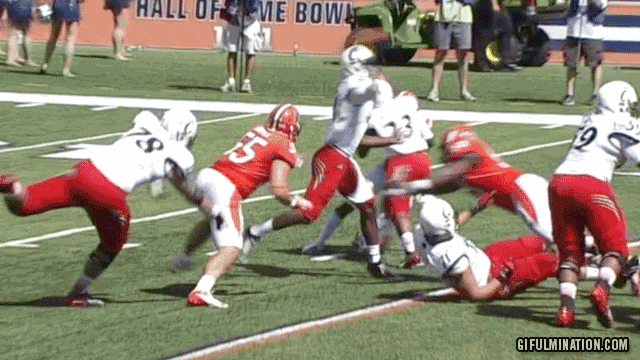I might just change the subject of this blog to cover every sack the Packers allow this season. That's really what it's becoming at this point, anyway. Cincinnati vs Green Bay. The Packers allowed four sacks and really ended up blowing the game at the end, so let's look at some pseudo-X-and-Os to kill time until the Packers' next game (in two weeks..)
Play 1: Sack due to Evan Dietrich-Smith
[1] Cincinnati comes with five rushers, the only time they sacked Rodgers with more than four rushers all game. James Starks (running back) is going to block the blitzing safety (A-gap), and there's a stunt bringing the DE (highlighted) to the opposite A-gap, but there's nothing too exotic from this blitz.
[2] Starks cuts the safety, and Evan Dietrich-Smith (center) is about to engage with his man. This is going to be an issue, because EDS is going to get pushed into Starks, causing him to fall.
[3] As you can see, Evan Dietrich-Smith didn't have much of a chance once he started moving backwards into Starks.
[4] Sack.
Play 2: Sack due to David Bakhtiari
[1] The first of three four-man rush sacks is on the rookie left tackle. He's first off the line of scrimmage, and quickly tries to get to the outside to get in the way of the wide-defensive end.
[2] Instead, the defensive end takes an inside angle, forcing the rookie to come back to his original latitude. Bahktiari can't catch up, though, allowing a rusher into the backfield.
[3] Rodgers sees the blitz and tries to move outside, but Josh Sitton's man is coming around the edge.
[4] There's no where for him to run.
[5] Sack.
Play 3: Sack due to Don Barclay
[1] Another four-man rush. This time, the sack is attributed by a quick jump by the left defensive end.
[2] Getting to the edge quicker than Don Barclay (right tackle), he's able to close in on Rodgers while the tackle is still trying to get set up.
[3] Using his length, he's able to grab Rodgers's uniform as he's falling.
[4] Sack.
Play 4: Sack due to Evan Dietrich-Smith
[1] There's no stunt or quick jump on this one, just a bull-rush (and possible missed "hands to the face" call) by Cincinnati's Peko.
[2] If you really wanted to call this hands to the face, I'd bet you could. I'm not making excuses for EDS, though. He gives up a lot of ground here.
[3] About six to seven yards worth, actually, ending in the center's back ramming into the quarterback.
[4] No-defensive contact sack.
.png)
.png)
.png)
.png)
.png)
.png)
.png)
.png)
.png)
.png)
.png)
.png)
.png)
.png)
.png)
.png)
.png)





.png)
.png)
.png)
.png)
.png)
.png)
.png)
.png)
.png)
.png)
.png)
.png)
.png)
.png)
.png)
.png)
.png)
.png)
.png)
.png)
.png)
.png)
.png)
.png)
.png)
.png)
.png)
.png)
.png)